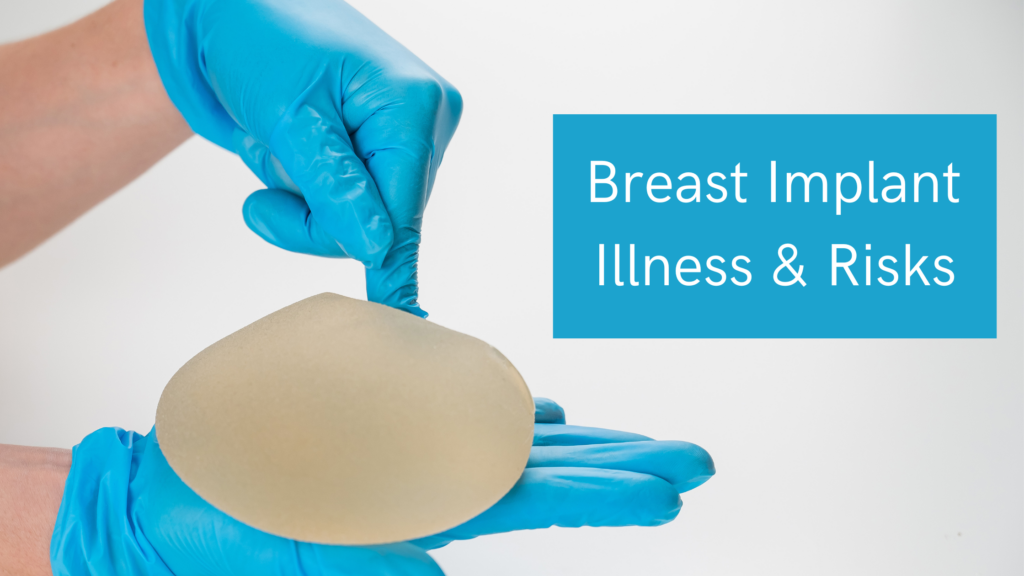
This blog is all about shattering myths.
- Breast implants are not just bags of water and salt.
- Big breasts are not needed to feel like a woman or beautiful.
- Mastectomy surgery does NOT remove breast cancer stem cells (click here for better ways to suppress stem cells and prevent recurrence).
- Wearing a bra does not prevent your breasts from sagging, and not wearing one doesn’t cause your breasts to sag.
If you are thinking about getting breast implants or have them and wondering why you have been feeling sick ever since—or if you just want to explore your options—then keep reading. I also want to clearly state that you should always talk to your doctor before trying anything new. Every woman’s situation and decisions are unique. This blog intends to provide information so you can make the most informed decisions for your body.
Before we get started discussing breast implant illness (BII) and risks, here are a few things that every woman should know about bras:
-
- Let your boobs breathe! Wearing a sweaty bra for too long can cause fungal and yeast infections, rashes, and blisters.
- Ditch the underwires! Besides being super uncomfortable, they (and tight bras) can dig into your breasts and restrict lumphatic drainage. Underwire bras also impede energy flow or the chi of your body’s meridians, and the irritation can lead to dermatitis. You also don’t want metal wrapping your sensitive breasts all day.
- Trash the toxicity! The bra and underwear areas are two of the most porous areas of a woman’s body. Heat, moisture, and sweat can enable the chemicals to seep into your skin––just like a nicotine patch. While Europe has banned over 1,000 chemicals in their clothing products, American intimates are hardly regulated. These chemicals include formaldehyde, chlorine bleach, PFAS, and heavy metals. I suggest organic cotton bras.
- To learn more about bras and find the best post-lumpectomy or mastectomy swimsuits and bras, please read this blog post.
Breast Implant Risks
Saline and silicone breast implants are like toxic soups in your body. Despite what many doctors say, saline implants are just as dangerous as silicone gel. This is because saline implants are not sealed airtight, nor are the filing valves 100% secure. Because of this, bodily fluids, yeast, molds, and bacteria can enter the implant, leading to various health issues.
Many people also don’t realize that breast implants have a warranty of about ten years and may need to be removed or replaced. The longer they remain in the body, the greater the risk of complications developing. A study of 99,993 women with breast implants (56% silicone) found some fascinating insights:
- Silicone implants were associated with higher rates of Sjögren’s syndrome, melanoma, scleroderma, rheumatoid arthritis, capsular contracture, and stillbirth. Here’s another study about complications in children born to women with implants.
- Saline implants were more likely to rupture in the short term—sending their contents (including mold, yeast, plastic, bacteria, etc.) throughout your body.
In 2021, the US Food and Drug Administration (FDA) finally added a label with a boxed warning and a patient checklist that includes risks and will inform people that implants are not medical devices that will last a lifetime. The warning lists possible symptoms such as fatigue, joint pain, tiredness, brain fog, and memory loss. It also explains the possible link to a rare type of cancer known as anaplastic large cell lymphoma (BIA-ALCL). Most doctors and researchers also state that they do not know enough about the harm that breast implants can cause since the study of BII is so new. As of 2023, there is no official test to detect breast implant illness. However, if you check your inflammatory markers, (HS – CRP, LDH, ESR) and they are elevated, your body is probably reacting to the implants.
Breast Implant Illness (BII)
If you or someone you know has (or may think they have) Breast Implant Illness (BII), the first step is to listen to this podcast episode on reversing BBI with an RN, certified Functional Diagnostic Nutrition® Practitioner, and Breast Implant Illness Expert. The study of Breast Implant Illness is relatively new, and sometimes doctors and people use other words to describe the issues, such as Generalized/unexplained illness, breast or silicone implant disease, and autoimmune/autoinflammatory syndrome induced by adjuvants (ASIA).
Diagnostic Nutrition® Practitioner, and Breast Implant Illness Expert. The study of Breast Implant Illness is relatively new, and sometimes doctors and people use other words to describe the issues, such as Generalized/unexplained illness, breast or silicone implant disease, and autoimmune/autoinflammatory syndrome induced by adjuvants (ASIA).
Except for certain medical situations and conditions, foreign objects should not be placed in your body. This is because your immune system will attack foreign invaders, sending your body into a highly inflamed state. An autoimmune reaction is when the body attacks something within itself, and autoimmune illnesses are major signs of BII. Some of the more common ones include lupus, Lyme disease, rheumatoid arthritis, scleroderma, and Hashimoto’s thyroiditis.
Symptoms of BII
While there have been over 50 reported symptoms and still more to discover, here are a few of the common ones:
Musculoskeletal:
- Joint pain.
- Muscle pain.
- Muscle weakness (myopathy).
Cognitive:
- Anxiety and depression.
- Brain fog.
- Fatigue.
- Memory loss.
- Trouble concentrating.
Systemic:
- Autoimmune condition symptoms or diagnosis.
- Chronic pain.
- Dry eyes or low vision.
- Hair loss.
- Skin problems such as rashes.
- The implant itself
- Pieces of the implant
- Leaking silicone (it can be carcinogenic)
- Chemical exposure
- Bacteria or other contaminants (biofilm contamination)
Breast Implant Cancer
Breast Implant Illness is a completely separate condition from Breast Implant-Associated Anaplastic Large Cell Lymphoma (BIA-ALCL). It is a rare cancer of the immune system that occurs only in women with breast implants. It’s confusing, but this cancer is not a type of breast cancer. Rather, it is a kind of lymphoma that grows in the portective tissue capsule that the body has formed around the implant.
Fat Transfers
 For some people, a fat transfer could be a better option. If you are thinking about it, please listen to this podcast episode on the pros and cons of fat transfers. The host, Diane Kazer (former pro soccer player and now a health coach and Functional Nutrition Practitioner), shares her experience with BII, explant surgery, and why she chose a fat transfer.
For some people, a fat transfer could be a better option. If you are thinking about it, please listen to this podcast episode on the pros and cons of fat transfers. The host, Diane Kazer (former pro soccer player and now a health coach and Functional Nutrition Practitioner), shares her experience with BII, explant surgery, and why she chose a fat transfer.
A fat transfer breast augmentation is a cosmetic procedure that takes fat cells from other areas of your body (stomach, thighs, arms, etc.) and injects them into your breast. The procedure carries fewer risks than breast implants but they are not always successful. A fat transfer may increase your breasts by one or two cup sizes but will not firm or lift them up.
I know all of this can seem totally overwhelming and scary—but it doesn’t have to be.If you have had a mastectomy or lumpectomy, give your body time to heal from that surgery and the breast cancer. Implants require more surgery and anaesthesia which weakens your Immune System. Embrace your scars and love your body. Once you are over the trauma of the breast cancer healing journey, then you can make a more infomed decision.
Remember, you are not alone. All of us in the Breast Cancer Conqueror community are cheering for you. We also offer private coaching to help you make the best decision, and you can contact me and the team any time with questions. It’s time to live your vibrantly healthy life!
Author: Dr. Veronique Desaulniers, better known as Dr. V, is a Doctor of Chiropractic & has 44 years of experience in the wellness industry. For personalized support, please partner with a trained Breast Cancer Conqueror Coach.

